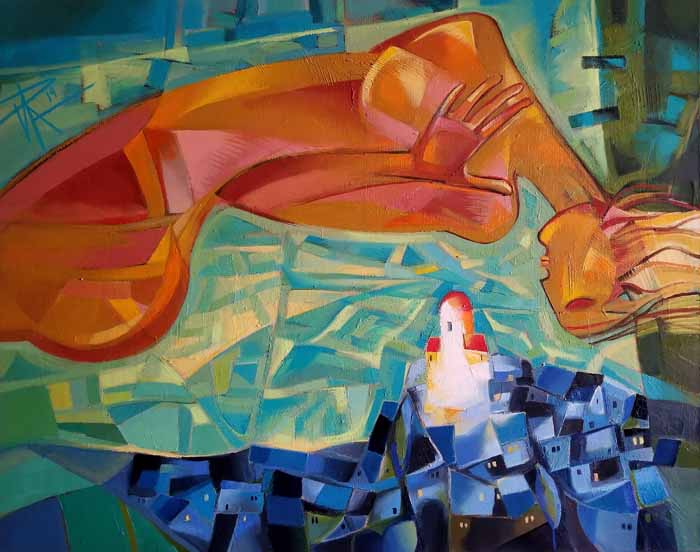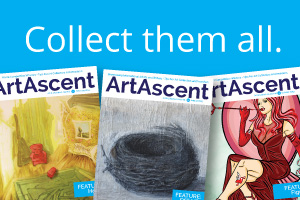Artist Interview | Ira Simidchievav
Become acquainted with perhaps a few unknown dimensions – thoughts, ambitions, wisdoms, life changing moments – of this inspiring artist.

When it comes to your art, explain what you do.
I focus on contemporary abstract figurative art and abstraction, but I also have a strong interest in the landscape. I utilize an eclectic, contemporary approach and emphasis on shape and colour. My preferred media and materials are oil paints on canvas.
I maintain the view that an artwork is a metaphor, and everything in a painting is language: the colour talks, the shape talks and the different elements in the painting communicate among themselves. The whole painting communicates a non-verbal message that is transmitted to the perceiver. Painting is a way of expressing oneself, an inherent necessity.
What project are you working on now?
Currently, my art, inspired by the psychoanalytical thought, is experienced, just like psychoanalysis, as ongoing research of states of mind and feelings concerning their connections to reality. My last project’s concept deals with the psychoanalytical theory. The title, “Holding and Containment of a Good Enough Painting,” implies emotional nurturance and describes a complex mutual interaction between two human beings, a mother, child, psychoanalyst, patient etc. This theoretical concept is considered to be a core mechanism under which psychoanalysis works. Winnicott, a favourite writer of mine, who is considered to be a physician by education, but I think he was actually an artist by soul, talks about the terms as related to a “space between an inner and an outer world, which is also the space between people – the transitional space – that intimate relationships and creativity occur.” I take that psychoanalytical concept and apply it to the creative process between a painter and a painting.
Although my paintings are thematically related to psychoanalysis, and their titles are wordplays featuring key psychoanalytical terms and concepts, unlike Conceptual (Postmodern) Art, they do not need narrative to exist as artworks. They are open to viewers not familiar with the psychoanalytical theory.
Why do you do what you do?
Art has always been both medicine and food for me. It does not feed the physical body but does feed the inner world. Painting has always been, for me, something very intimate and personal that I can always return to no matter what. Painting is not only a profession but a necessity for me. I paint because I need to paint.
How has your practice changed over time?
I paint for many years, and my paintings style changes over time. I am always surprised at how different each painting is every time. It feels like the painting has a life of its own. I do not think of a style when I paint. After all, an artist always paints herself or himself. Painting is a projection. Each and every piece of art is a projection of the inner worlds of the artists. The creative process is a unique combination of projections and introjections, a communication with oneself.

What is your strongest childhood memory?
I remember that when I was a child, I had two dreams about what I wanted to become when I grew up. The first thing was to be like Pocahontas, and the second one was to become an artist. By fulfilling the second dream, becoming an artist, I actually fulfilled the first one as well. Because in and through art, I gave freedom to that little girl’s desires, I had the chance to invest all the energy steaming from her wish to live in the wild, ride horses, undergo rituals, hunt for a living, and understand the language of nature.
What is your scariest experience?
When I was a little girl, I was very scared of my friend’s father, who playfully pretended to be someone who eats children and wants to eat us up. I took his words seriously.
What superpower would you like to have and why?
I would like to have the power to create a world in which artists struggle less financially. A world in which artists can have a salary job, just like nurses or social workers. A world in which an artist is considered as important as any other occupation.
What is your pet peeve about the art world?
The fact that Postmodern (Conceptual) art is entirely institutionalized and oil paint on canvas is considered old fashioned.
Do you make a living off of your art?
Yes, New York was the place where I was able to start making a living off of my art.

Which place in the world do you find to be the most inspiring?
I grew up in Eastern Europe, in an environment of a long and agonizing transition between communism and democracy that affected all aspects of people’s lives, including artistically. Communism had encapsulated the artistic development for years, and Postmodern aesthetics and ideas found their way much later than they did in Western Europe and the USA. Modernism during the post-Soviet era was used as a way to demolish the harsh canon of the idealized naturalistic style of socialist idealism. Even though I grew up and progressed as an artist in times when socialist realism technically was far back in history, this was the artistic spirit I inherited. I received a professional art training in Bulgaria, Holland and the UK, which helped me furnish a generous and eclectic contemporary artistic style. New York was the place I really felt to be my true artistic (and not only artistic) home, the place to inspire me the most. My permanent relocation to New York was an act of freeing myself artistically and discovering myself.
What’s the most indispensable item in your studio/practice?
My small and cozy studio in Queens, New York is usually filled with the scent of fresh coffee and piled with big colourful paintings (those of both mine and fellow artists), antique collections, a collection of handmade cloth dolls, and a library of various books mainly about art and psychoanalysis but also fiction. This is a place where apart from painting, I like having thoughtful conversations with colleagues and fellows about art, psychoanalysis and other topics. All of the above items, together with the paints and canvases, are indispensable.
What is the best piece of advice you’ve ever been given?
“If you hear a voice within you say “you cannot paint,” then, by all means, paint and that voice will be silenced.” – Vincent Van Gogh
What are your hobbies?
Apart from being an artist, I am also a psychoanalyst and practicing psychoanalytically orientated therapist. I find that art is very related to psychoanalysis in many ways. A detailed sense of my view about the topic can be gained from my article What Is Common Between Psychoanalysis And Art published in the Manhattan Instate for Psychoanalysis blog:
https://manhattanpsychoanalysis.com/blog-post/psychoanalysis-art
Creatively, where do you see yourself in the next five years?
In five years, I see myself working and exhibiting in NYC.
Ira Simidchieva is currently based in New York.
Visit https://www.irasimidchieva.com




